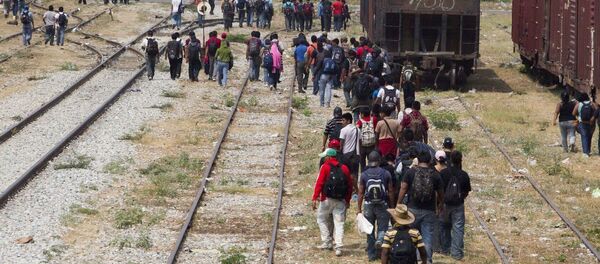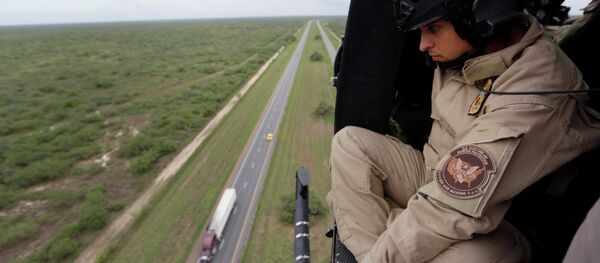On Monday the caravan bivouacked in Tapachula, a city in Chiapas on Mexico's Pacific coast, just inside the border from Guatemala. It's 1,700 miles from there to the US-Mexico border, but the caravan has already come 400 miles from where it started in San Pedro Sula, Honduras, on October 13. Most of the migrants come from Guatemala and Honduras. The Washington Post estimated on Monday that depending on the route selected by the travelers, the caravan would arrive at the US border sometime in mid-November.
In Tapachula they were joined by another 1,500 travelers from Guatemala; United Nations Deputy spokesman Farhan Haq told reporters in New York on Monday that put their number at around 7,200.
US President Donald Trump has used the caravan to fan the political flames in the US. With the midterm elections only weeks away, he's using the caravan's growing size as a bludgeon to equate policies and politics by the Democratic Party with the xenophobic fears being whipped up among his white political base about an army of brown people bearing down on the US and all they hold dear.
"Every time you see a Caravan, or people illegally coming, or attempting to come, into our Country illegally, think of and blame the Democrats for not giving us the votes to change our pathetic Immigration Laws! Remember the Midterms! So unfair to those who come in legally," Trump tweeted Monday morning. Trump has made anti-immigrant rhetoric and policies a cornerstone of his entire foray into national politics.
Radio Sputnik's By Any Means Necessary spoke with freelance multimedia journalist Cady Voge about the reasons for the caravan's incredible size, why migrants are leaving their homes in such large numbers to come to the US and what they experience once they arrive at the US border.
She told hosts Eugene Puryear and Sean Blackmon that the migrants are traveling in caravans instead of individually or in small groups mostly for safety reasons. "Criminal groups control a lot of those routes," especially narco-traffickers, she said, and people prey on migrants, "so some years ago, human rights advocates, human rights organizations" such as Pueblo sin Fronteras (People Without Borders) "started organizing these caravans to organize people in groups, saying, ‘There's power in numbers.'"
As the caravan enters a town or city, "not at every single stop along the way last time, but in some of the major stops," the migrants will hold a peaceful march through the town, chanting, "We're migrants, we're international workers, we're not criminals!" Voge said this is "to draw attention to their plight, to their mission, to migrate safely and also… fight back on the narrative that they are criminals coming to storm the US, which they absolutely are not."
Voge said this caravan might be larger than past caravans because of the increased safety in these groups as opposed to the smaller operations in the past that were more vulnerable to abuse by criminals and opportunists. She also noted that at least in some cases, it's the remaining parts of families whose first members to go to the US or Mexico already braved the journey, and now they feel comfortable embarking to rejoin them.
She said that once migrants arrive in Tijuana at the border, they have to apply for asylum by saying they "have a credible fear" of returning to their home country. Once let into the US, though, they're held in a concrete holding cell, colloquially called "the ice box" for its extreme discomfort, for up to eight days. The men's sides have no mattresses, the holding cells are crowded, and migrants often don't eat because the food is spoilt. Women and children do have mattresses and blankets.
Following the "ice box," migrants go to a detention center, which Voge said migrants have told her they are "happy to be in" because the detention center, though basically a prison, "is so much better than the conditions in the holding cell." She said migrants are "kind of ‘broken' by this point and just thankful to be there." However, "after time, that becomes horrible as well."
Voge said that casting the migrants as criminals is only possible by "keeping the issue out of the conversation of what's actually happening on the ground in these countries and what they're facing, trying to divert the attention from that" and the United States' involvement in that.
In the past, Mexican officials have given out humanitarian visas and work permits to migrants in caravans "to control the optics, because of course there was a bunch of media attention on the group. I mean, images of so many people moving — this time it's even more, thousands more — so I think something similar may happen again," Voge told Radio Sputnik. Mexico's welcome has caused the sizes of caravans to shrink before they reach the Mexico-US border 1,700 miles away.
Voge said that an important way Americans can support migrants is to call their US congressional representatives, in particular about improving conditions in detention centers. Donation funds have also helped to move migrants on their odyssey by buying them bus or train tickets. Solidarity marches, not just in one's hometown but also at the arrival site on the US-Mexico border are also helpful because, Voge points out, migrants have "only encountered people in ICE" by the time they get into the country.







